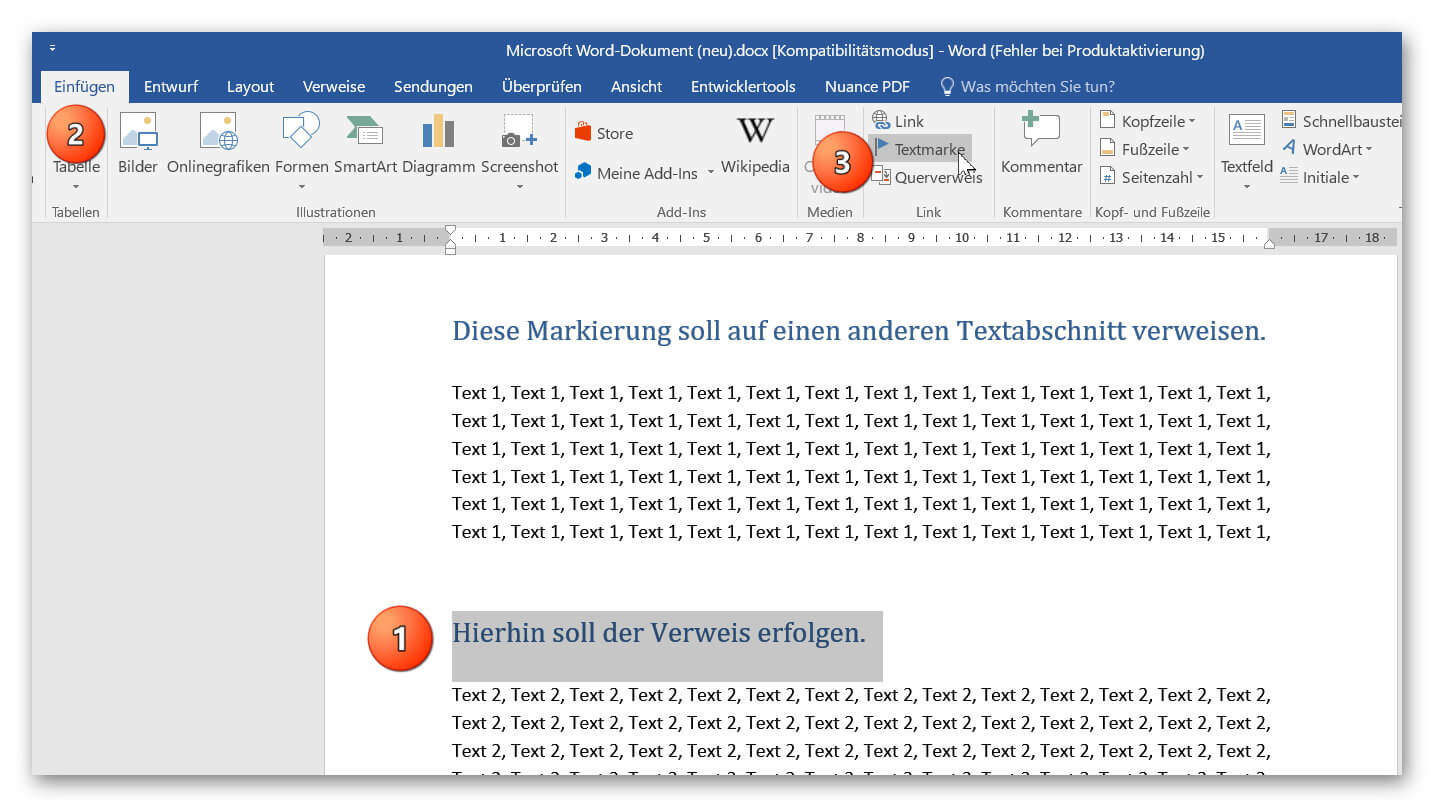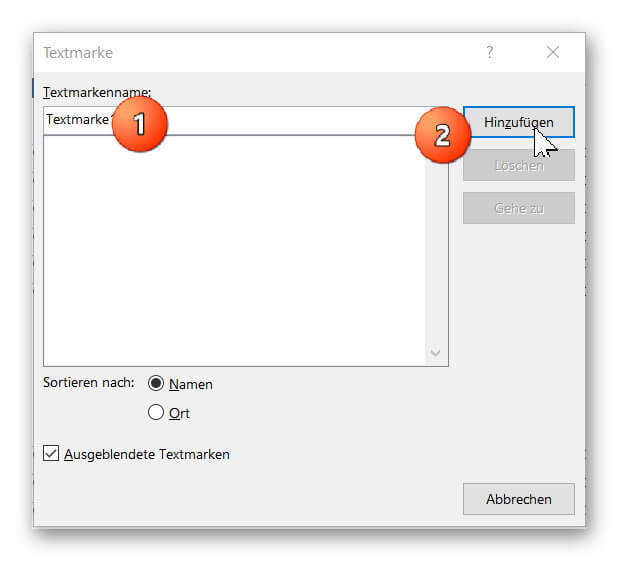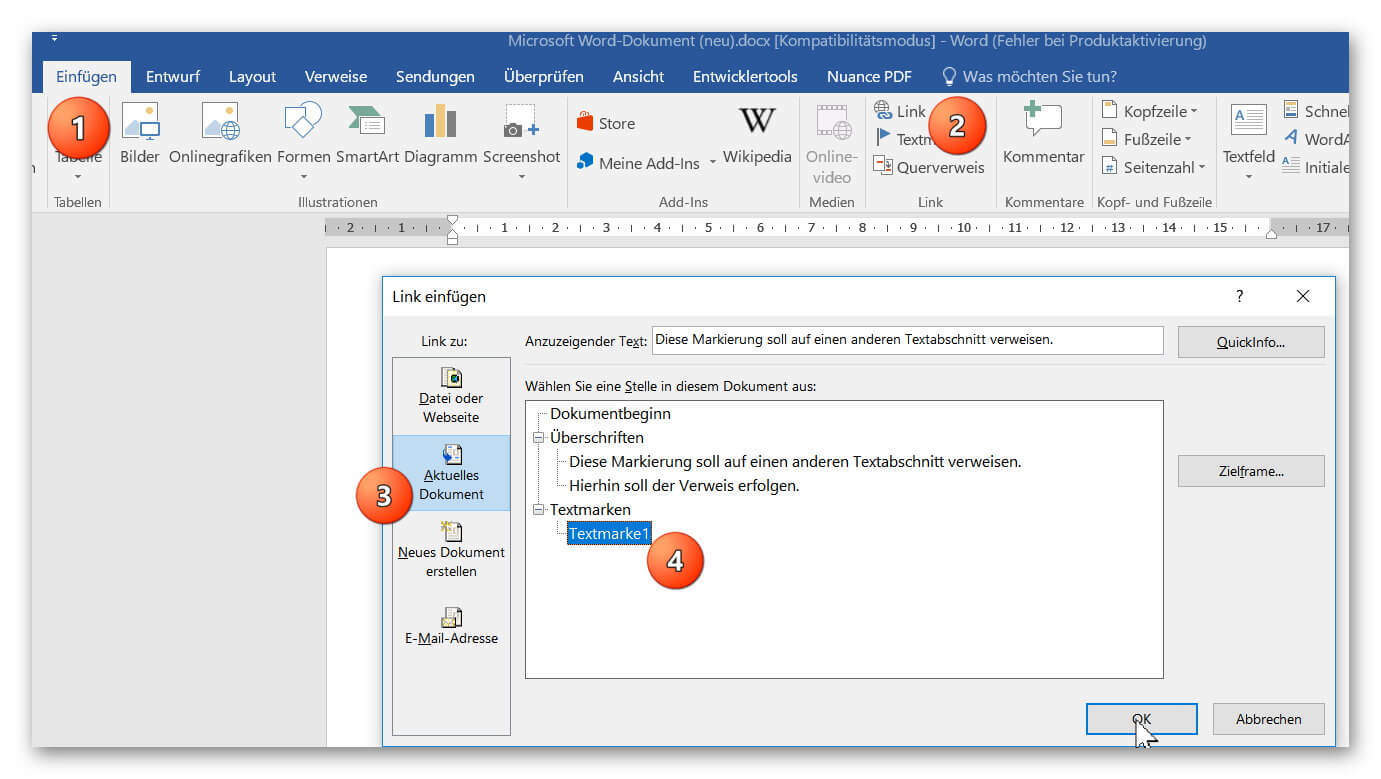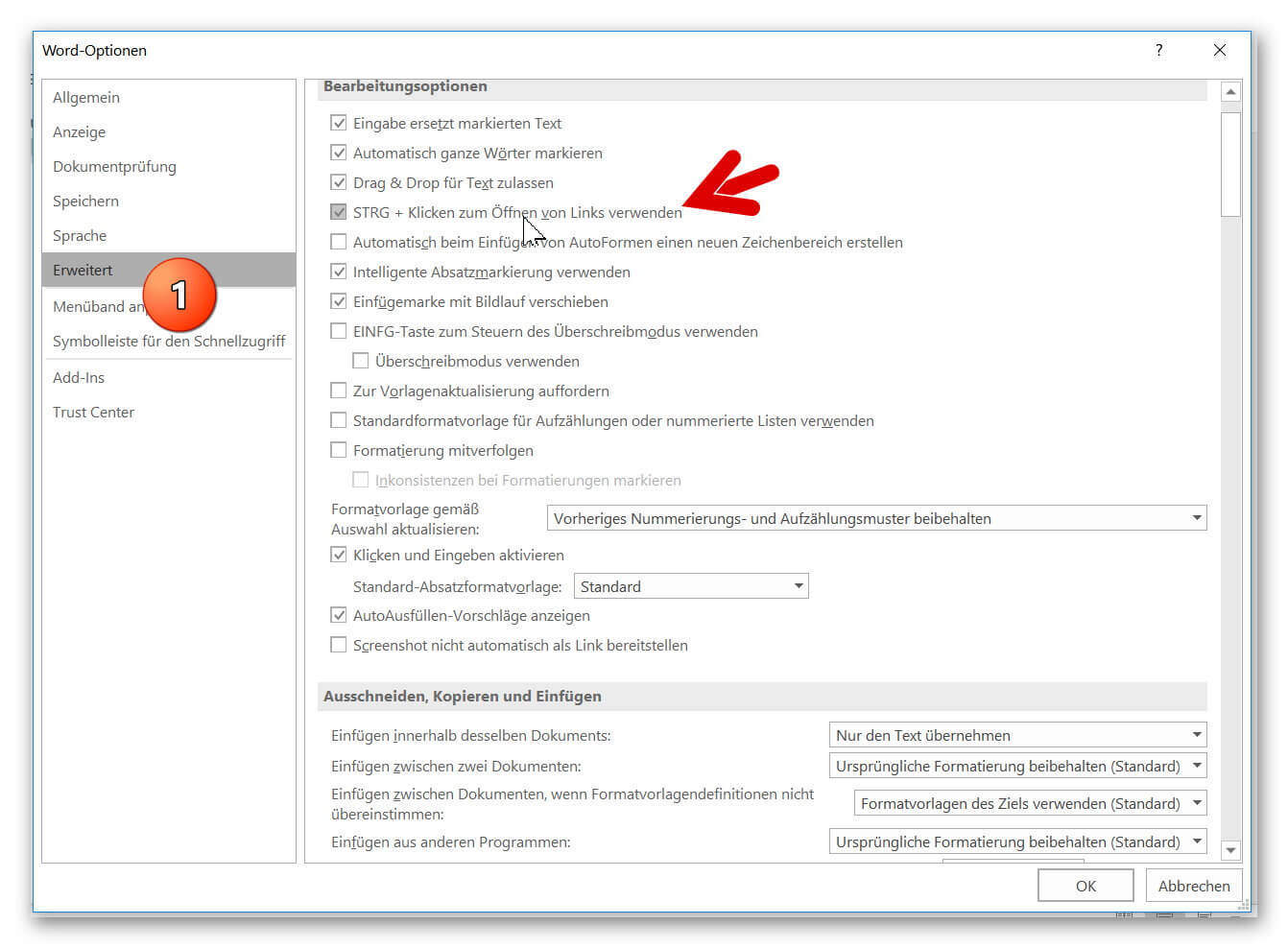Use bookmarks and cross-references in Word
Surely you’ve already thought about it, that in long Word documents it would not be practical to constantly scroll through textual pages to search for certain passages of text, but to move as comfortably as on a web page by clicking through your pages.
Fortunately, the solution to this problem is quite simple, and is based on the functionality of the table of contents in Word.
As it is done in Word 2016, and you can create such a dynamic document, you will find out in our article.

Use bookmarks and cross-references in Word
Surely you’ve already thought about it, that in long Word documents it would not be practical to constantly scroll through textual pages to search for certain passages of text, but to move as comfortably as on a web page by clicking through your pages.
Fortunately, the solution to this problem is quite simple, and is based on the functionality of the table of contents in Word.
As it is done in Word 2016, and you can create such a dynamic document, you will find out in our article.

1. Set bookmarks in Word
1. Set bookmarks in Word
In our small example, we have created 2 sections of text.
The goal should be that we can click on a section of text, or a word, and then land directly in the 2nd text section.
First, we set a text marker in the target section.
For this purpose we should mark the headline or the beginning of the section, and then go to the tab: “Paste” on “Bookmark” and give our bookmark a unique, and unique (if we later want to use more than one bookmark) name.
See picture: (click to enlarge)
In our small example, we have created 2 sections of text.
The goal should be that we can click on a section of text, or a word, and then land directly in the 2nd text section.
First, we set a text marker in the target section.
For this purpose we should mark the headline or the beginning of the section, and then go to the tab: “Paste” on “Bookmark” and give our bookmark a unique, and unique (if we later want to use more than one bookmark) name.
See picture: (click to enlarge)


2. Set internal links in Word.
2. Set internal links in Word.
In the previous step, we set our goal, where we want to land later.
Next we just have to define which text components should refer to this goal.
To do this, mark the word next, or the text section that represents the starting point, in the tab: “Paste” on “Link” and in the following dialog window select: “Link to: Current document”.
There, the desired text marker out, and confirm your choice with “OK”.
From now on, your document is dynamic and you can click on your internal link while holding down the CTRL key + left mouse button.
In this way, you can jump through a document by skillfully setting internal bookmarks and links without having to scroll through page by page text.
Of course, you can apply the same principle to images or shapes that you have inserted in your document.
See picture: (click to enlarge)
In the previous step, we set our goal, where we want to land later.
Next we just have to define which text components should refer to this goal.
To do this, mark the word next, or the text section that represents the starting point, in the tab: “Paste” on “Link” and in the following dialog window select: “Link to: Current document”.
There, the desired text marker out, and confirm your choice with “OK”.
From now on, your document is dynamic and you can click on your internal link while holding down the CTRL key + left mouse button.
In this way, you can jump through a document by skillfully setting internal bookmarks and links without having to scroll through page by page text.
Of course, you can apply the same principle to images or shapes that you have inserted in your document.
See picture:
3. Run link in Word directly
3. Run link in Word directly
By the way, you can only execute links in Word by using CTRL + Left mouse button. By the way, this is a security setting that Microsoft installed for a good reason and set as default.
Because as someone who did not create this document, I can assume that the link points to an expected point in the document, but I can not rely on it.
It is also quite possible that such a link to a self-executing exe. File refers to a dubious website or other harmful to my PC content.
Therefore, as soon as you move the mouse over the link, the destination of the link to the control is displayed in a small context window.
To override the default, and click through your document just as you would on an internet page, just go to the tab:
“File” – “Options” – “Advanced”
and look there in the section editing options the entry: “CTRL + click to open links”
and deactivate the hook there.
See picture: (click to enlarge)
By the way, you can only execute links in Word by using CTRL + Left mouse button. By the way, this is a security setting that Microsoft installed for a good reason and set as default.
Because as someone who did not create this document, I can assume that the link points to an expected point in the document, but I can not rely on it.
It is also quite possible that such a link to a self-executing exe. File refers to a dubious website or other harmful to my PC content.
Therefore, as soon as you move the mouse over the link, the destination of the link to the control is displayed in a small context window.
To override the default, and click through your document just as you would on an internet page, just go to the tab:
“File” – “Options” – “Advanced”
and look there in the section editing options the entry: “CTRL + click to open links”
and deactivate the hook there.
See picture: (click to enlarge)
Popular Posts:
Warum dein Excel-Kurs Zeitverschwendung ist – was du wirklich lernen solltest!
Hand aufs Herz: Wann hast du zuletzt eine komplexe Excel-Formel ohne Googeln getippt? Eben. KI schreibt heute den Code für dich. Erfahre, warum klassische Excel-Trainings veraltet sind und welche 3 modernen Skills deinen Marktwert im Büro jetzt massiv steigern.
Cybersicherheit: Die 3 größten Fehler, die 90% aller Mitarbeiter machen
Hacker brauchen keine Codes, sie brauchen nur einen unaufmerksamen Mitarbeiter. Von Passwort-Recycling bis zum gefährlichen Klick: Wir zeigen die drei häufigsten Fehler im Büroalltag und geben praktische Tipps, wie Sie zur menschlichen Firewall werden.
So sieht das wirklich perfekte Homeoffice-Setup für 2026 aus
Ihr Homeoffice ist veraltet? Steigern Sie 2026 Produktivität & Gesundheit. Unser Guide zeigt das perfekte Setup: von ergonomischen Stühlen und 4K-Webcams bis zu Mesh-WLAN und Kabelmanagement. So investieren Sie in Ihre Karriere.
Internet, Telefon & TV: Die besten Komplettpakete
Internet, TV & Telefon aus einer Hand? Wir vergleichen die Komplettpakete von Telekom, Vodafone, O2 & 1&1. Wer punktet bei Speed, TV-Komfort (MagentaTV vs. GigaTV) und Preis? So finden Sie das beste Triple-Play-Angebot für Ihre Adresse.
5 Anzeichen, dass dein Chef dich im Homeoffice digital überwacht
Nur weil du im Homeoffice bist, heißt das nicht, dass dir niemand zusieht. "Bossware" ist auf dem Vormarsch. Wir zeigen 5 subtile Anzeichen für digitale Überwachung – von "Teams-Status"-Kult bis zu verdächtigen IT-Tools. So erkennst du die Warnsignale und schützt deine Karriere.
Schluss mit dem Tool-Chaos: 5 Apps, die Euer Office wirklich produktiver machen
Schluss mit digitaler Reibung: Diese 5 Apps machen Ihr Büro wirklich produktiver. Entdecken Sie, wie Asana, Loom, Notion, Zapier und Slack die Effizienz steigern, Meetings reduzieren und Ihr Team smarter vernetzen – wenn man sie richtig einsetzt.
Popular Posts:
Warum dein Excel-Kurs Zeitverschwendung ist – was du wirklich lernen solltest!
Hand aufs Herz: Wann hast du zuletzt eine komplexe Excel-Formel ohne Googeln getippt? Eben. KI schreibt heute den Code für dich. Erfahre, warum klassische Excel-Trainings veraltet sind und welche 3 modernen Skills deinen Marktwert im Büro jetzt massiv steigern.
Cybersicherheit: Die 3 größten Fehler, die 90% aller Mitarbeiter machen
Hacker brauchen keine Codes, sie brauchen nur einen unaufmerksamen Mitarbeiter. Von Passwort-Recycling bis zum gefährlichen Klick: Wir zeigen die drei häufigsten Fehler im Büroalltag und geben praktische Tipps, wie Sie zur menschlichen Firewall werden.
So sieht das wirklich perfekte Homeoffice-Setup für 2026 aus
Ihr Homeoffice ist veraltet? Steigern Sie 2026 Produktivität & Gesundheit. Unser Guide zeigt das perfekte Setup: von ergonomischen Stühlen und 4K-Webcams bis zu Mesh-WLAN und Kabelmanagement. So investieren Sie in Ihre Karriere.
Internet, Telefon & TV: Die besten Komplettpakete
Internet, TV & Telefon aus einer Hand? Wir vergleichen die Komplettpakete von Telekom, Vodafone, O2 & 1&1. Wer punktet bei Speed, TV-Komfort (MagentaTV vs. GigaTV) und Preis? So finden Sie das beste Triple-Play-Angebot für Ihre Adresse.
5 Anzeichen, dass dein Chef dich im Homeoffice digital überwacht
Nur weil du im Homeoffice bist, heißt das nicht, dass dir niemand zusieht. "Bossware" ist auf dem Vormarsch. Wir zeigen 5 subtile Anzeichen für digitale Überwachung – von "Teams-Status"-Kult bis zu verdächtigen IT-Tools. So erkennst du die Warnsignale und schützt deine Karriere.
Schluss mit dem Tool-Chaos: 5 Apps, die Euer Office wirklich produktiver machen
Schluss mit digitaler Reibung: Diese 5 Apps machen Ihr Büro wirklich produktiver. Entdecken Sie, wie Asana, Loom, Notion, Zapier und Slack die Effizienz steigern, Meetings reduzieren und Ihr Team smarter vernetzen – wenn man sie richtig einsetzt.



































